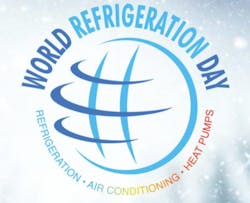World Refrigeration Day 2021: People and Careers in Focus, as Industry Prepares for Change
World Refrigeration Day 2019 and 2020 were focused on the importance of commercial refrigeration to the world.
World Refrigeration Day 2021, tomorrow, June 26, shines a light on the people who make refrigeration possible, and the many career opportunities the industry offers. More than a dozen events are planned the week before and week after WRD21, to share career information and success stories.
“Our message this year is highlighting many of the team members around the world we have who are working in the refrigeration industry,” said Brandon Marshall, North America Marketing Manager-Thermal & Specialized Solutions for Chemours, a major global provider of refrigerant solutions, during an exclusive interview with Contracting Business.
“There is a significant shortage of labor in the HVAC and refrigeration market, and we’re attempting to broadcast that, and give some visibility to our engineers, sales people, and marketing people, to show that there are careers in this industry above and beyond being a technician, but also to show people the value of a career in HVAC and refrigeration. HVAC and refrigeration is a critical infrastructure and we need to make sure we have a strong workforce of dedicated people, to keep storage facilities cold and homes cool or warm,” Marshall said.
Marshall added that all manufacturers share this concern, and it truly is an all for one, one for all scenario.
“We want to support all of our industry partners,” Marshall said. “We develop the latest and greatest technologies, the most energy efficient, most sustainable systems, and without competent technicians to install the equipment, all the work we do on the manufacturing side is for naught. It’s an important point for us. World Refrigeration Day has traditionally focused on lower temperature applications, but the message is clear to those who are participating that it is a broad industry that includes HVAC.”
One of Chemours' spotlights on industry professionals can be found on its OpteonTM LinkedIn page where they are featuring Chemours "cooling champions" and the careers they have followed.
Changes Taking Place
But as essential and beneficial as refrigeration has been to the world, major changes continue, related to the refrigerants used to power these life-sustaining and comfort-bestowing systems. And now, with a new EPA regime and White House administration at the helm of environmental policy, long-anticipated changes will be initiated. The American Innovation and Manufacturing Act, passed by Congress in December 2020, begins a phase down of the production and consumption of hydrofluorocarbons (HFCs) over the next 16 years. Additionally, a handful of states, with California in the lead, have established their own rulemaking to reduce HFCs.
The HVACR industry’s major refrigerant formulators and marketers, including Chemours and others, are ready, with lower-GWP (Global Warming Potential) products.
One is R-454B, which Chemours is marketing as OpteonTM XL41. The R-454B formulation is also being offered by additional global suppliers under different brands.
“Much of the appeal of R-454B, is that it is the lowest GWP R-410A replacement on the market, at 466 (AR4), which is well below CARB's (California Air Resources Board) threshold of 750 GWP. In application testing, data from various locations and different applications, from chillers to residential equipment, show it offers energy reduction and charge reduction benefits in addition to the low GWP benefit,” Marshall shared.
HVAC to Also See Changes
As a reminder to HVAC contractors, R-410A -- which has only been in use since 1996, when it was introduced by Carrier as PuronTM -- is the next popular comfort system refrigerant currently undergoing a phase down, which will begin in 2022. It will continue to be used for servicing systems, but in 2024-2025, its manufacture will begin to decline.
And, as often happens with refrigerant phase downs, contractors are often slow to adapt. They’ve got lots on their plates; they’re often ill-informed about policy details; they need training to understand new refrigerant properties; and they’re content. Hey, R-410A works great, just like R-22 did.
But for those HVAC contractors wanting to change soon, and for those who ultimately will do the same, new refrigerants for new equipment will be available. One is R-32, by Daikin. Others from Chemours are R-454B (Chemours’ OpteonTM XL41), and three others to help residential and light commercial contractors move from R-22: MO-99, NU-22B and R-407C.
“All of those are marketed under the Freon brand. Chemours developed those products several years ago, to help meet that need, but then we also went into the marketplace to offer training and to make documentation available in terms of retrofit guidelines. We work to align with the original equipment manufacturers (OEMs) to understand acceptable practices, which is a very important point when the subject is retrofits, for example, changing from R-22 to MO-99. Will something go wrong with the compressor? Will the line sets remain the same? There are definitely considerations contractors need to take when making those transitions, and we publish guidelines related to that,” Marshall said.
Chemours has a “Tech-to-Tech” phone line for peer technician assistance, and World-Class Training on FreonTM Products.“Contractors who are using our products can call in and speak to our seasoned technicians, who are employed by us. They will walk the contractor through issues, help them understand if there are any changes that need to be made, and support them during the retrofitting process.”
Marshall has a heart for what the HVAC technician experiences in a day because he used to be one.
“When I was a technician, I obtained my R-410A certification through a Rheem program. R-410A has been out there, for about 25 years; not as long as R-22. There’s still a healthy install base of R-410A, but we don’t think it will be to the same degree and magnitude we saw with R-22,” he suggested.
About Refrigerant Flammability
On May 27, Johnson Controls reported it would to provide Opteon™ XL41 (R-454B) as the future refrigerant solution for its ducted residential and commercial HVAC products, as well as its air-cooled scroll chiller applications, as replacement for R-410A.
Classified as mildly flammable (A2L), Chemours reports XL-41 is safe for use when applicable codes and standards are followed. Other stated benefits of using Opteon™ XL41 include:
• Excellent performance in normal and high ambient conditions
• A low temperature glide with easy top off after leaks
• Miscibility with polyolester (POE) lubricants.
Mildly flammable refrigerants are safe when used with certain precautions. Still, their use is causing municipalities and others to test them for degree offlammability, and then, building codes must be rewritten to allow for their use, which Marshall said is expected to be completed by 2024-2025. He also suggested there may be other precautions in place, such as additional leak detection sensors.
In March of this year, Air Conditioning Heating Refrigeration Institute (AHRI) release the results of flammability tests, which tested the refrigerant’s flammability in five different scenarios. The tests found A2L refrigerants to be difficult to ignite, and had low flame speeds. SEE THIS LINK.
Industry testing that Chemours supported in conjunction with AHRI had similar positive results. Refrigerant ignition occurred in the worst-case conditions, which was a very contained, small, non-ventilated space.
“We found those results to be favorable in helping build a degree of comfort with fire service personnel.
With that -- and also getting all this data pulled together so that regulators, code professionals and fire service personnel have what they need to make decisions -- the other side we’re working on is training,” Marshall shared. “Training, not only for distributors and manufacturers on how they store the refrigerant, and how they charge it in a factory environment, but we’re also partnering with several companies and have been active in the industry for many years in publishing papers and hosting presentations, to talk about these working fluids.”
Those publications include papers published by Refrigeration Service Engineers Society (RSES) and communications to industry trainer-members of HVAC Excellence, and contractor-based associations.
“We recently signed a sponsorship with Air Conditioning Contractors of America (ACCA), so we intend on working closely with ACCA. They have approximately 60,000 professionals -- 3,000 company member -- contractors inside their association, and we want to be able to take concerns the industry has, work with them to address those concerns, and provide training and information," Marshall shared.
Meeting Training Need
Marshall agrees that training is, and always has been a contractor need. With A2L refrigerants, the need is a bit hotter. “Due to the A2L designation, people are looking for training, to understand the differences [between flammable and non-flammable refrigerants]. When you go back six years, the rise of A3s (propane) started. A3s have a significantly higher degree [of concern] compared to an A2L in terms of what it takes to create an ignition event. But I think two of the biggest challenges are, to overcome any fear factors associated with mildly flammable refrigerants, and to be certain users understand that the systems that they’re installing today that contain R-410A are not going to change dramatically when we move to XL-41. So that’s an area I think people are watching, to see what will come out next."
Contracting business owners and managers, he said, are looking for answers and guidance related to the handling and transporting these refrigerants.
“There are definitely questions on the business side for contractors which they’re looking for answers on, but really I think it’s overcoming that initial A2L [concern], making sure people know the system differences, and that contractors will be employing the best practices that we’ve always advocated, and practices that need to continue.
“It’s never good to cut corners. Employing all the best field practices is something people will be adamant about. We want to be certain that installations are completed in a quality fashion,” Marshall stated.
Correction: an earlier version of this story misstated the year the R-410A phasedown will begin and the years its reduced production would commence. The article also misidentified he AIM act as The American Infrastructure and Manufacturing Act.










